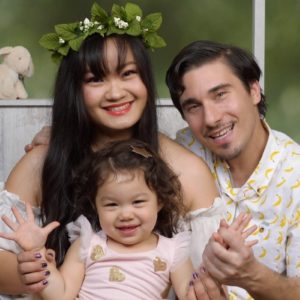Diane Obomsawin, also known by her pen name Obom, is a Quebec author, illustrator, and animator. After becoming a legend in the comic art scene in Montreal, she forayed into animation—and we can all be glad for it. Her films are quirky and evocative; funny and full of heart. Her latest short film, “I Like Girls” (2016), based on her graphic novel On Loving Women, won the Nelvana Grand Prize for Independent Short at the 40th Ottawa International Animation Festival. It is a film close to her own heart, featuring the story of her own coming of age, and coming out. I was privileged to discuss the importance of positive Queer representation, and combatting stereotypes of homosexuality in film and TV, with a leader and role model in LGBTQ media such as Diane.
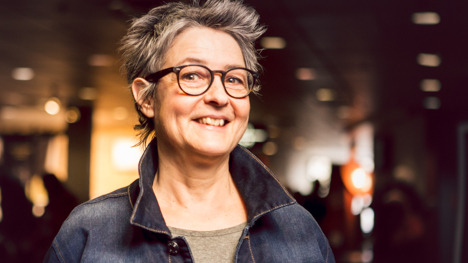
When did you first become interested in animation?
I began making graphic novels when I was 10 years old. I was always drawing, but it wasn’t until a friend recommended animation to me, that later in life – I was 35 – I joined the animation program at Concordia.
How did you become involved with the NFB?
My teacher at Concordia, Wendy Tilby, had long made productions with the NFB. I was lucky to learn from her; at the same time that she taught me the ‘correct’ methods to animate, she encouraged me not to change from the different ways I’d been working. The NFB was looking for someone to do a few author commissioned short films, “Understanding the Law,” and she recommended me. It was a great, because although they were commissions, I could do them in my own style. At first I was nervous about bringing my humor into them—but they told me to have fun, so I did!
How did you come to write the graphic novel, On Loving Women?
I wanted to tell tiny, real stories. All my life, lesbians and gay people have been marginalized. Now there is less marginalization, and more films and TV series talk about lesbian and gay people’s experiences. So when I went to write the graphic novel, it felt as though society was ready to hear these stories—and I felt ready to tell them. I hadn’t always been. But even if the timing is better now, for so many years, lesbians – gay people, but lesbians especially – have not been represented in films and TV. So as much as we’re talking about these experiences more now, we can never talk about them too much. With the Bechdel test, we see that women are already under-represented in movies, and lesbians have been practically nonexistent; aside from the old trope of lesbian and gay love ending in tragedy! I wanted to show the reality of lesbian’s experiences – the joy, bittersweetness, sexuality – in their own words.
What was your process in interviewing women for the piece?
I chose 10 friends of all different ages. My hope was to interview women young to old to reflect the variations in stories across generations. The youngest was 28, and the oldest was 70. But that didn’t translate into the film—the oldest woman is actually Charlotte, but she appears to be the youngest because the actress was young. But I purposefully cast young actors and a young composer, because it’s a film about youth. I asked my friends about their first attraction, not first love. And first attraction might begin very young – ages 5, 6, 7 – long before they realize their sexuality, or fall in love with another woman.
And all of the little details in the story – did they just emerge during your talks?
Oh yes, I didn’t change anything. I recently asked my friend, “Is it true? You ate Pepsi dipped ice cream cones?” and she said, “Yeah, absolutely!” The details came naturally. I think it helped that I didn’t directly ask them about their experiences, so much as their smallest memories – anything that came to the conscious. I was so surprised by some stories. One friend, she never consciously or unconsciously felt attracted to another girl, nor realized that she was a lesbian. It all came together for her in a single day, when she was in college. She tried LSD and fell in love with a woman, in that order.
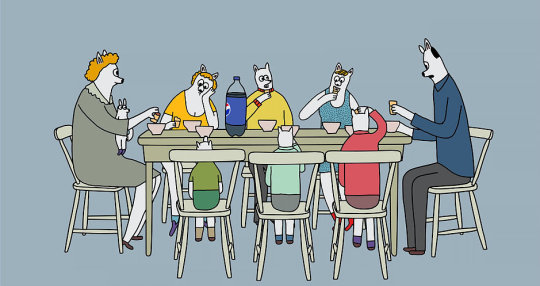
Whoa, what a story. It must have been tough to choose only a few for “I Like Girls”!
So difficult. I chose four: the ones I felt to be the most romantic, the goofiest – Wonder Woman with a horse face – and my own. As well as the saddest story, Marie’s. Hers is even more sad in the book: her mother gave her a terrible time, trying to put her into treatment for her “problem”. Her experience is what I mean by generational difference. Marie is only 5 years older than me, and just from those 5 years, our realities were so disparate. The culture shifted and perceptions changed—not totally, but quickly. They impacted our parent’s perspectives. For her family, and those of my other older friends, coming out was a very big deal. “You’re not my daughter anymore”—they considered it unacceptable. But when I came out, I was accepted. My parents told me, “We love you, we want you to be happy”. I was lucky. But even though it’s easier today, it’s still not easy. In dramatizing the experience of coming out, I was thinking about young people who are going through it now.
Have any responses to the film stayed with you?
Yes—it’s been so touching to hear from young women that they identified with a character, or that the film helped them in some way. One even sent me a picture of a tattoo she got of one of the graphic novel characters. I remember reading The Price of Salt by Patricia Highsmith (adapted into the film Carol, 2015). It was the first novel that ended happily for women in a lesbian relationship. I felt such joy and relief seeing myself in those characters. And so did countless lesbians and gay people who have written to her for years since!
What were techniques you used to make “I Like Girls,” and how did you choose to make them animals?
For some of the scenes, I used rotoscoping. The scene with two characters in bed together, I filmed dancers, for their comfort level and ability to move. Then I drew over them. It’s already difficult to draw two bodies entwined, but it’s even more so with a non-realistic art style like mine. And I also rotoscoped because it was important to me that the character’s movements be sensual, and that they be sexy. There’s a stereotype of gay women as lacking sexuality, and I wanted to make a point against that. And my non-realistic style is also why I gravitate toward animals rather than humans; if I could draw people that didn’t look so boring, I would! But the main reason to make them animals was to ensure that my friends wouldn’t feel too close when they saw their stories unfold on-screen. They could still recognize themselves, but with a degree of separation.
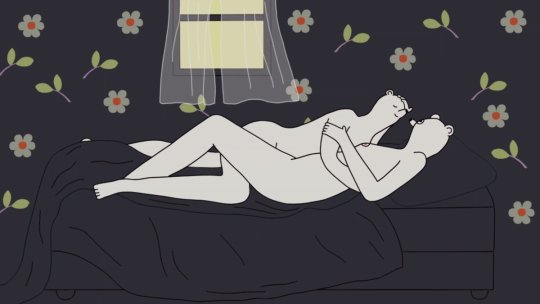
Do you have a favorite among your films, or love them equally?
I think I love them equally. Well… maybe “Kaspar”, perhaps because it didn’t do well at festivals. It’s like if you have one in the bunch that is less successful, you actually like it more! “Here and There” was about my own adolescence, growing up; “Kaspar” was about Kaspar Hauser, who grew up in a cave before dying very young; and “I Like Girls” is of course about coming of age. I realized recently that they all talk about childhood! So the next one will be something new. It also won’t have voiceover – there will be dialogue, but not voice-over.
What are you currently working on?
I just wrapped up a visual art installation in Quebec City called “La Forêt” (“The Forest”). We projected images of a forest upon three charcoal covered walls. My aim was for the spectator to feel that they are not supposed to be there; they are spying on the forest life, and the forest is revealing its secrets. Tiny things happen, mostly from mythology and fairy tales. Little Red Riding Hood makes an appearance.
That’s awesome. Why do you like doing gallery installations?
It’s a different way to tell a story! Unlike graphic novels and films, they don’t require a beginning and end. You can come into the story at any point. I have another installation coming up for spring 2019: that will be half animation, half-graphic novel, and spread through three gallery rooms of a small museum. The theme is dreams and mythology. I dream a lot, a lot, a lot—so I record them in a journal. I believe there are links between our dreams and mythology.
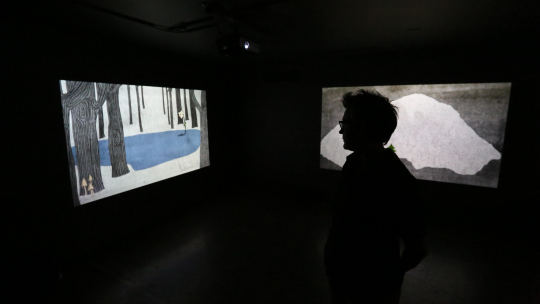
Do you have other projects in the works?
I’m working on my friend Khoa Lê’s film, “Dans nos ville”. He brought on 18 other creators, including me, to each do a segment on a different fairytale. It’ll play for 7 days in 7 different places, narrated by an actor and with live music. It’s exciting, but my segment is almost 4 minutes long—and I have a month and a half to do it! So I’m using more abstract animation than usual.
I’m also doing the opening animation for Le Carrousel festival in Rimouski, which has a focus on children’s and YA work. The animation is a series of loops that go up and down—it’s meant to have a feeling of perpetual movement, reminiscent of a carousel.
Do you have a favorite artist and favorite animated film?
One of my very favorite artists is Copi. I like his simple drawings and his writing, which is absurd, poetic, and corrosive all at once. I discovered him when I was young, and didn’t know whether he was a man or a woman until I was an adult, and found out that he was an Argentinian transvestite and playwright, and lived in Paris.
So far as films… I could choose a different favorite animated film every week. But for today, I will go with the very beautiful strange film Nighthawk from Spela Cadez. After I saw it, I asked myself, “What just happened to me?”. Watching that film is a very sensitive experience.
Thank you so much for the interview Diane! I look forward to keeping up with your many projects. Especially excited for your next short film!
– Cooper



